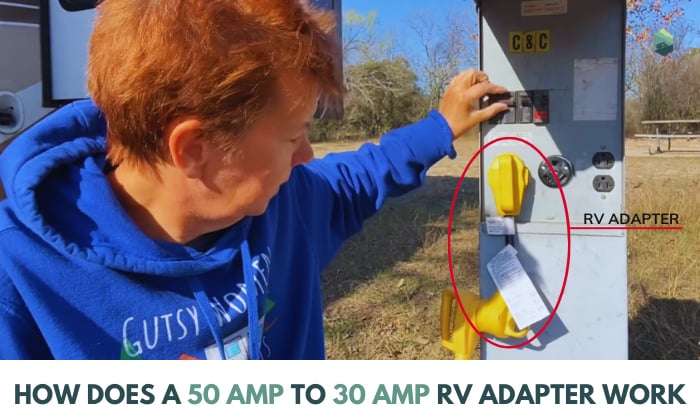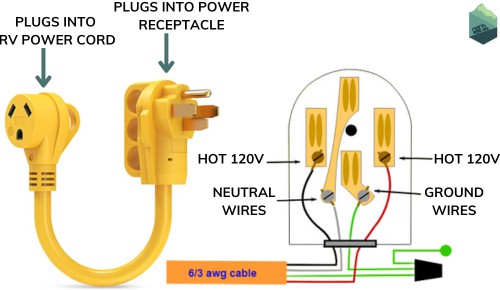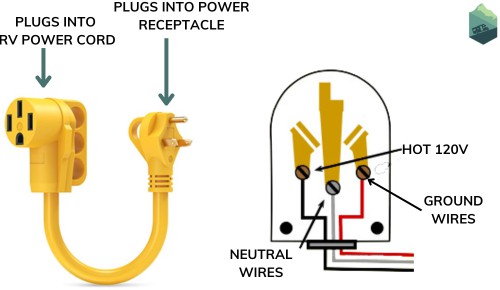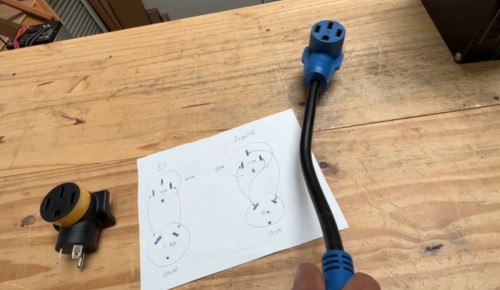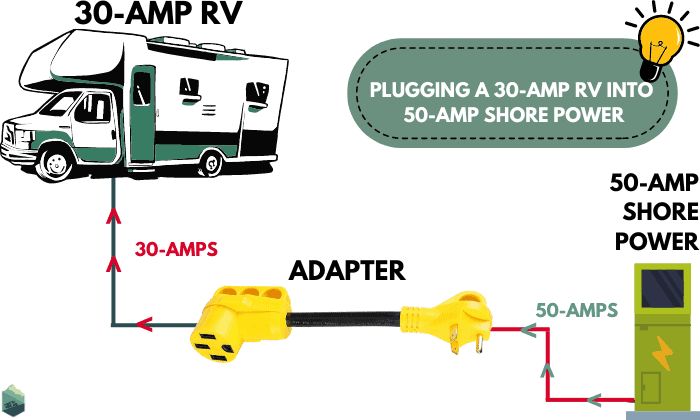The simple process of power splitting provides the basis for answering the riddle, “How does a 50 amp to 30 amp RV adapter work?” This device has physical and electrical features that allow it to bridge the differences between a 50- and 30-amp system.
And if you’re like most RV owners, you’d want to know exactly how it does this.
Read on.
Page Contents
How a 50-amp to 30-amp RV Adapter Works
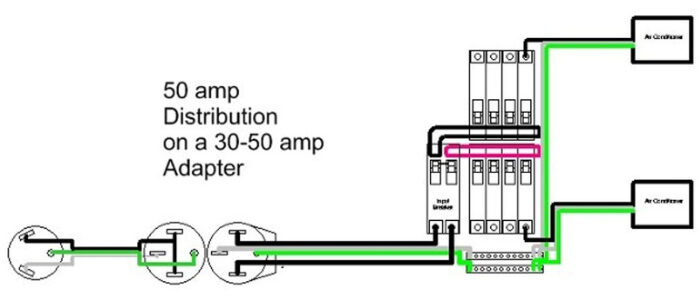
Most RVs feature 120-volt appliances requiring 30 amps of power. However, some power-hungry devices and machines need 240 volts or up to 50 amps of electricity. Hence, many RV parks provide shore power in 30- and 50-amp capacities.
Unfortunately, some RV parks only have 30-amp outlets, making it problematic for 50-amp RVs. A 50-amp to 30-amp RV adapter should do the trick.
So, how does it work?
A 50-amp to 30-amp adapter splits the 30-amp outlet’s “live” or “hot” wire into two to supply sufficient power to the two “live” cables on the RV’s 50-amp system without damage or any untoward incident to either system.
Let’s differentiate a 50-amp from a 30-amp system to appreciate the adapter’s function.
1. A 50-amp plug
If we look at a typical wiring diagram for a 50-amp system, we’ll notice four “holes” in the outlet or four “prongs” in the plug.
Two prongs or holes are “hot” or “live,” each carrying 120 volts for a combined 240 volts. The other two prongs are the ground and neutral wires. This system delivers 12,000 watts (240 volts x 50 amps = 12,000 watts).
With 12,000 watts of power, you can run several power-hungry appliances (i.e., water heaters, ovens, refrigerators, and air conditioners).
2. A 30-amp plug
While a 50-amp system has four prongs or holes, a 30-amp device will only have three.
Two are the neutral and ground wires, and another for the “hot” wire carrying 120 volts. This characteristic gives the 30-amp system a 3,600-watt maximum output (120 volts x 30 amps = 3,600 watts).
3. Bridging the difference
It’s worth noting that 50-amp and 30-amp systems have ground and neutral wires. They differ only in the extra 120-volt prong in the 50-amp system.
An adapter solves this issue by splitting the 30-amp system’s single 120-volt element into two. It allows 120-volt electricity to flow into two “prongs,” a fundamental requirement of 50-amp systems.
The adapter has two connectors on either side. It has a NEMA 14-50 female connector to accommodate the 50-amp RV plug and a NEMA 14-50 male connector on the opposite side to plug into a 30-amp outlet.
Moreover, the NEMA 14-50 female connector features bridged “hot wires” to convert the 30-amp outlet’s single “live” line into two.
So, if you ask yourself, “Can I plug my 50 amp RV into a 30 amp plug?” you know the answer. However, please understand that your maximum wattage draw will only be 3,600 watts, making it nearly impossible to run some RV appliances.
Plugging a 30-amp RV Into 50-amp Shore Power
What if you parked your 30-amp RV in an RV park with only 50-amps of shore power? Can you plug a 30 amp into a 50 amp system?
Of course, you can. However, you will need a different dogbone adapter – a 30-amp female connector and a 50-amp female connector. This arrangement allows you to convert 30 amp to 50 amp.
It’s worth pointing out that a 50-amp to 30-amp RV adapter connects two “hot wires” at the 50-amp section. On the other hand, a 30-amp to 50-amp dogbone adapter doesn’t have the “hot wire” cross bridging. One of the prongs doesn’t even have a cable connected to it.
If you worry about the RV park’s higher amperage rating potentially frying your 120-volt, 30-amp RV appliances, you can always get a dogbone adapter with a surge protector built-in.
Conclusion
How does a 50 amp to 30 amp RV adapter work? Like any power adapter, this device has features that allow two different electrical systems to link without causing unnecessary events in the RV or shore power utility.
Knowing how it works allays any fear RV owners might have when they plug their motorhomes into “unknown” electrical outlets. It ensures safety while guaranteeing more pleasant RVing adventures. It’s a small device worth including in one’s RV essentials.
“Hi, I’m Francis’ husband—Calvin. Our story began with our shared passion for traveling. I have had a career journey for over 11 years at Ford Motor Company, where I took on the role of BMS SW Process Engineer.
Together with my wife, I have dedicated countless hours to exploring every nook and corner of the world. Ten years living in an RV may seem long, but time seems to fly by when I’m doing what I love with the person I love.
FMCA’s 103rd International Convention & RV Expo in Gillette, WY,
Like my wife, I hope to help you see the beauty of traveling off the beaten path by sharing insights into this lifestyle. In addition to my corporate roles, I also launched our website – Outdoorbits, in 2015 and continue to contribute my knowledge and skills to the present day. And I’ll be completely honest with you—no hiding the truth or sugarcoating the possible challenges.
So, if you want to run away from the busy lifestyle to embrace nature, I’m your guy.”
